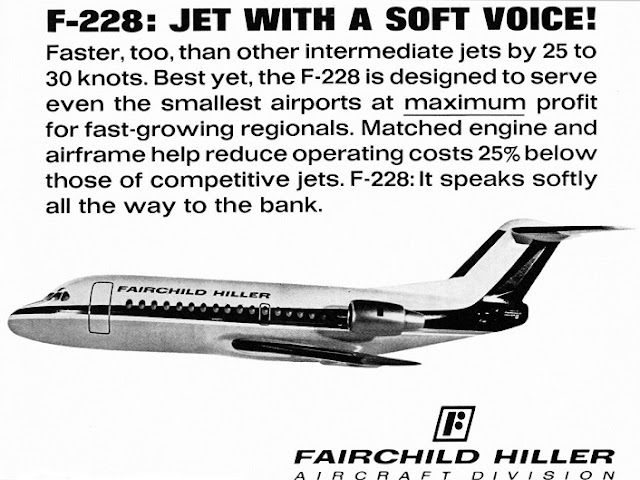The Fairchild 228 was a regional jet developed in the United States by Fairchild Hiller in association with Fokker based on the new F-28 Fellowship.
On January 4, 1967, an agreement was signed between Fairchild Hiller Corporation and Fokker to assemble the new model and also to sell the Fokker F-28 in the Western Hemisphere. This agreement was announced at a press conference on February 1, 1967.
Fairchild optimistically estimated orders of 260 to 460 units for the North American market and 600 to 800 aircraft for the rest of theworld.
The 228 was basically an F-28, only one meter shorter, with three-slotted flaps and different engines. The new aircraft would cruise at 800 km/h (500 mph) with a máximum range of 649 km (403 mi). It had seating for 50 passengers and could operate on 1,200-meter (4,000-foot) runways.
The engine chosen for the new Project was the Rolls-Royce RB-203 Trent high-bypass ratio (3.3:1) twin-flow engine specially designed for the F-228. This powerplant was 15% more fuel-efficient, quieter, and had greater thrust than the Rolls-Royce Spey engine that powered the Fokker F-28.
Initially, it was decided to purchase sub-assembled F-28 parts. Both models were intended to have the largest parts pool. Fokker withdrew the fuselajes of examples c/n 11005 (A-5) and c/n 11007 (A-7) from the F-28 production line, modifying them for the Fairchild F-228 variant, renaming them S-1 and S-2. These parts were shipped to Baltimore, United States, and transported by road to Hagerstown, Maryland. The components of the first fuselage (S-1) arrived in October 1967.
The first order came from West Coast Airlines, which ordered three aircraft. This announcement was made by Fairchild on September 20, 1967. Later, Interior Airways signed a letter of intent in February 1968 fort wo F-228s, planning to put them into service by January 1971.
Towards the end of 1967, the rigorous testing program of the selected engine, - Rolls-Royce Trent-, began, yielding good results.
Unfortunately, by 1968, delays in the planned work occurred, causing Fairchild to postpone the first flight date. Among the reasons cited was the American manufacturer's inability to deliver the model to the intended specifications, while also having to overcome financial problems.
In June 1968, Fairchild canceled the F-228 project, with two aircraft already well under construction. As compensation, it acquired ten F-28 Fellowships for sale in the United States, Canada, and Mexico. However, it was only able to sell two aircraft. The remaining aircrafts were returned to Fokker. They were flown to Woensdrecht to be offered to new operators.
Source: airlinercafe, Jan FolkertHomma, Arnold Bejeman.










